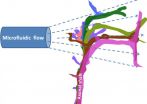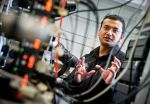INFORMATION:
About The University of Texas at Arlington
The University of Texas at Arlington is a comprehensive research institution and the second largest institution in The University of Texas System. The Chronicle of Higher Education ranked UT Arlington as the seventh fastest-growing public research university in 2013. U.S. News & World Report ranks UT Arlington fifth in the nation for undergraduate diversity. Visit http://www.uta.edu to learn more. Follow #UTAdna on Twitter.
UT Arlington researchers demonstrate direct fluid flow influences neuron growth
2014-10-06
(Press-News.org) A University of Texas at Arlington team exploring how neuron growth can be controlled in the lab and, possibly, in the human body has published a new paper in Nature Scientific Reports on how fluid flow could play a significant role.
In a new study co-authored by Samarendra Mohanty, leader of the Biophysics and Physiology Lab in the College of Science, the researchers were able to use microfluidic stimulations to change the path of an axon at an angle of up to 90 degrees. Axons are the shafts of neurons, on the tips of which connections are made with other neurons or cells.
The publication adds insight to the long accepted idea that chemical cues are primarily responsible for axonal pathfinding during human development and nervous system regeneration. Such knowledge could be essential for advances in spinal cord injuries, where fluid flow can guide regenerating axons, in addition to affecting the bio-chemicals in the injured site.
Finding a non-invasive, highly effective tool to guide neuron growth is important to neuroscientists hoping to determine how neural circuitry works and develop ways to test potentially life-changing therapeutic drugs on so-called lab-on-a-chip devices. Lab-on-a-chip devices incorporate several lab functions on a microchip.
Co-authors on the new paper are Ling Gu, Bryan Black, Simon Ordonez and Argha Mondal, all researchers in Mohanty's lab at the time of the research and Ankur Jain from the UT Arlington College of Engineering's mechanical and aerospace engineering department. The paper is called: "Microfluidic control of axonal guidance" and is available here: http://www.nature.com/srep/2014/141006/srep06457/full/srep06457.html.
"It is well known that fluid flow is involved in various processes during organ development. However, there was no evidence to confirm the influence of direct microfluidic flow on axonal migration," said Mohanty. "Through this line of work, our lab is discovering that it's not only chemical cues, but physical cues such as force, heat and flow that need to be looked at or used for understanding and control of neuronal guidance both in the lab and in the body."
The latest publication grew from work that Mohanty and colleagues at University of California, Irvine, published as the cover article in Nature Photonics in January 2012. That paper demonstrated the team's success directing axon growth using a particle rotated by a near-infrared laser beam so that it acted as a micromotor to create fluid flow. Gu, Black and Mohanty published research earlier this year in the journal PLOS One that described using near-infrared light generated heat to guide axon growth very efficiently, another advance the lab is working on.
To be sure that the flow - not heat or mechanical force generated by light - was the cause of axons' direction change the new work used a direct flow from a microtube.
Mohanty and the research team used retinal ganglion cells from common goldfish to test their theory about direct flow. In the lab, 35 percent of the growth cones tested responded to the fluidic flow from the microtube, with 78 percent turning toward the flow direction.
"The work that Dr. Mohanty's team is doing can translate basic science research into methods that could lead to great improvements in the area of health and the human condition," said Jim Grover, interim dean of the UT Arlington College of Science. "The fact that he has received funding from the National Institutes of Health and the National Science Foundation to further his ideas confirms that his lab is doing work valued by others in the field and that his outcomes will continue to be noted."
Black said the studies' authors have more work to accomplish. First, they'll try to establish parameters for the method.
"After we determine thresholds for effective axonal guidance versus damage or detachment, we can fabricate microfluidic platforms that will enable complex flow patterns and schedules," Black said. "This will teach us whether the process is reversible, among other things, and potentially allow us to produce simple neuronal circuits."
ELSE PRESS RELEASES FROM THIS DATE:
Are leaders born or made? New study shows how leadership develops
2014-10-06
URBANA, Ill. – Hardly a day passes without pundits crying for leadership in the NFL commissioner and team owners, among high-ranking government officials, and in other public figures. If University of Illinois experts didn't have evidence that this valuable trait can be taught, they might join the collective swoon that's engulfing much of the country.
But a new U of I study supports the idea that leaders are made, not born, and that leadership development follows a specific progression.
Past research suggests that leadership is 30 percent genetic and 70 percent a result ...
Natural gene selection can produce orange corn rich in provitamin A for Africa, US
2014-10-06
WEST LAFAYETTE, Ind. - Purdue researchers have identified a set of genes that can be used to naturally boost the provitamin A content of corn kernels, a finding that could help combat vitamin A deficiency in developing countries and macular degeneration in the elderly.
Professor of agronomy Torbert Rocheford and fellow researchers found gene variations that can be selected to change nutritionally poor white corn into biofortified orange corn with high levels of provitamin A carotenoids - substances that the human body can convert into vitamin A. Vitamin A plays key roles ...
Montefiore & Einstein investigators present research at 2014 AAP National Conference & Exhibition
2014-10-06
NEW YORK (October 6, 2014) – Investigators at The Children's Hospital at Montefiore (CHAM) and Albert Einstein College of Medicine of Yeshiva University will present their latest research on neonatal lung disease, reducing wrong-patient errors in the NICU, hormonal contraception and more at the AAP Experience, the National Conference & Exhibition of the American Academy of Pediatrics. The AAP Experience will take place October 11-14 in San Diego, California.
Judy Aschner, M.D., F.A.A.P., physician-in-chief, CHAM, professor of pediatrics and Michael I. Cohen, M.D., University ...
Less than half of Canadians exercise to relieve stress
2014-10-06
Hamilton, ON (October 6, 2014) – A research study out of McMaster University has found that only 40 per cent of Canadians exercise to cope with stress.
The researchers analyzed data from Statistics Canada's Canadian Community Health Survey of nearly 40,000 Canadians 15 and older. Of 13 coping behaviours or strategies polled, exercise was ranked eighth, meaning people were more likely to cope with stress by problem-solving; looking on the bright side, trying to relax, talking to others, blaming oneself, ignoring stress or praying, rather than being active.
"We know ...
New theorem determines the age distribution of populations from fruit flies to humans
2014-10-06
AUGUSTA, Ga. - The initial motivation was to estimate the age structure of a fruit fly population, the result a fundamental theorem that can help determine the age distribution of essentially any group.
This emerging theorem on stationary populations shows that you can determine the age distribution of a population by looking at how long they still have to live.
The mathematical discovery can help produce data with a wide range of implications, from predicting rates of infectious diseases, such as West Nile virus spread by mosquitoes, to anticipating the health care ...
The skin cancer selfie
2014-10-06
WASHINGTON, Oct. 6, 2014— Melanoma is the fifth most common cancer type in the United States, and it's also the deadliest form of skin cancer, causing more than 75 percent of skin-cancer deaths. If caught early enough though, it is almost always curable. Now a camera, capable of taking snapshots of the entire human body and rendering high-resolution images of a patient's skin may help doctors spot cancer early and save lives.
Developed by a team of researchers at Duke University in North Carolina, USA, the "gigapixel whole-body photographic camera" is essentially three ...
Most liver cancer patients do not receive proper care
2014-10-06
Many US patients with liver cancer—even those with early stage disease that can often be cured—do not receive treatment for their disease, according to an analysis of studies published between 1989 and 2013.
Less than one fourth of patients undergo curative treatment, and nearly 50% do not receive any treatment. Elderly, non-Caucasians and patients of low socioeconomic status had lower treatment rates than their counterparts.
"We found the low treatment rates among patients with early stage tumors particularly concerning. Many of these patients currently fail to receive ...
Blood levels of Vitamin D may affect liver cancer prognosis
2014-10-06
Vitamin D deficiency is linked with advanced stages of liver cancer and may be an indicator of a poor prognosis, according to a study of 200 patients with the disease who were followed for an average of 46 weeks.
Blood levels of vitamin D negatively correlated with stages of the disease, and patients with severe vitamin D deficiency had more than a 2-fold increased risk of dying during the study, according to Dr. Oliver Waidmann, senior author of the Alimentary Pharmacology and Therapeutics study.
INFORMATION:
...
Drug-loaded beads may help treat liver cancer
2014-10-06
A new phase 1 safety trial has demonstrated that idarubicin-loaded beads are well tolerated by patients but are toxic to liver cancer cells. Idarubicin is an anthracycline that is currently used to treat leukemias.
Two months into the 21-patient trial, the tumors of 28% of patients had complete responses to the drug, and the tumors of 24% of patients had a partial response. The findings are published in Alimentary Pharmacology and Therapeutics.
INFORMATION:
...
Eating white meat and fish may lower risk of liver cancer
2014-10-06
Eating lots of white meat (such as poultry) or fish may reduce the risk of developing liver cancer by 31% and 22%, respectively, according to a recent analysis of studies published between 1956 and 2013.
Consuming red meat, processed meat, or total meat was not associated with liver cancer risk. The Alimentary Pharmacology and Therapeutics findings suggest that dietary interventions may be a promising approach for preventing liver cancer.
INFORMATION: ...





